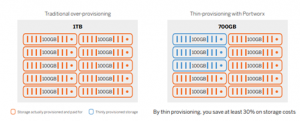Blog
27 March, 2024
July 12, 2021
The adoption of containers and the rise of Kubernetes has enabled applications to scale with incredible speed. Yet, the fact block storage was not originally designed for containers has led to problems, particularly in highly dynamic Kubernetes environments. Such challenges include: limited density of volumes per host, slow and unreliable failover, and environmental lock-in. Until now, this conflict has forced a choice: lose the speed advantage of containers, or pay more to overcome the disadvantages of existing storage systems.
Ultimately, achieving infrastructure savings through containerization requires a cloud native storage solution optimized for container environments.
Portworx Enterprise, from Pure, is a software-defined container storage platform, running in a single cloud or across multiple clouds, that uses your cloud block storage to provide containerized applications with:
scale-out storage
data availability
data security
backup
disaster recovery
Portworx enables enterprises to accelerate their container initiatives while dramatically reducing the costs associated with both infrastructure and operations.
Benefits of Portworx
CUT CLOUD STORAGE AND COMPUTE COSTS
By efficiently managing infrastructure, Portworx reduces compute costs of containerized stateful applications by 40-60% and reduces storage costs by 30% or more.
While Kubernetes automates the deployment of applications, enterprises must also be able to automate their underlying cloud infrastructure to ensure they have sufficient compute and storage available to scale applications. Despite the cloud’s promise of pay-for-use, the reality is that enterprises must overprovision block storage, often by 2-3x, and manage the additional complexity to achieve the required application performance. Translation: money wasted.
Likewise, when running stateful containers on the public cloud, each cloud provider limits the number of block devices that can be attached to a given VM. For example, on Amazon, this number is 40 EBS volumes. That means even if a VM has enough compute capacity to serve more than 40 stateful containers, you will have to provision an additional VM beyond this limit if you need additional volume. This overprovisioning drives up compute costs, not to mention the operational overhead of running more VMs than is strictly necessary.
PX-Autopilot enables you to cut your cloud storage costs in half by intelligently provisioning storage only when it is needed, automatically scaling on demand at an individual volume level, or even an entire cluster.

And because Portworx virtualizes cloud block volumes, you can easily run 1,000 or more stateful pods per host, eliminating VM-overprovisioning and further reducing cloud infrastructure costs.
Finally, additional cost savings can be derived from placing workloads on the most cost-efficient storage. Using Portworx to implement a dynamic, storage tiering model across flash, spinning disk and object storage allows organizations to significantly reduce storage costs while maintaining flexibility to meet app-level SLAs.